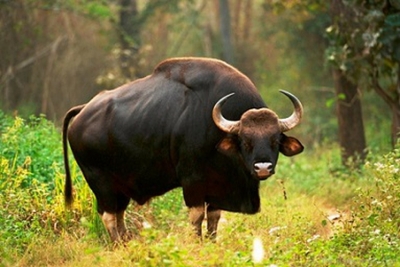
The gaur, also called the Indian bison, is the largest bovine species in the world and the tallest species of wild cattle.
It is native to South and Southeast Asia. It is a strong and massively built animal that grows to a height of 1.50 to 2.20 metres and weighs up to 1500 kg.
The gaur is found mostly in India in the Western Ghats in evergreen, tropical and subtropical moist broadleaf forests.
Its horns grow laterally from its face and form a wide hollow on the top of its head. Males or bulls are larger than females or cows, with an intimidating dorsal ridge and a heavy dewlap (loose fold of skin below the neck). The slightly raised back gives it a somewhat belligerent appearance! Adults are blue-eyed and dark brown in colour and the lower halves of their legs are pristine white.
The gaur eats leaves, stems, grass, seeds and flowers of various plants. They also like to eat the barks of certain trees. Peak feeding occurs between 6 am and 8 am, while afternoons are spent resting in the shade of trees.
This intimidating and magnificent animal is bold and fearless. It does not fear any animal or human. The adult gaur bull has very few natural predators. Even the mighty tiger is known to give this animal a wide berth! There are many instances of gaur chasing away tigers by charging towards them. In case of an attack, bigger gaur will surround weaker calves and face off with the predator. When the gaur assumes this battle position, very few tigers will continue the attack.
It is an endangered species protected under the Indian Wildlife Protection Act of 1972. Major threats are bovine diseases from domesticated cattle who often share grazing grounds with the gaur due to encroachment by humans.
Picture Credit : Google




